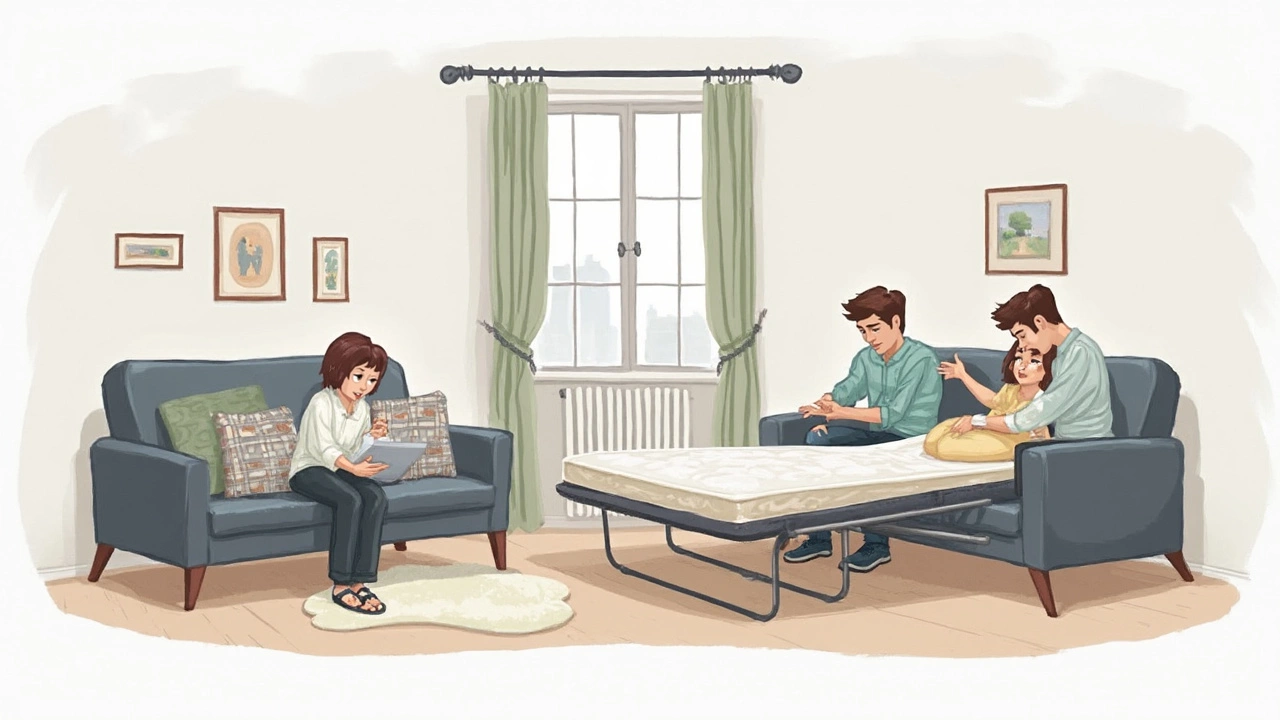You’ve probably eyed those sleeper sofas in the store, picturing yourself hosting friends or maybe squeezing extra sleeping space out of your living room. Sounds awesome, right? The thing is, not every sleeper sofa lives up to the hype. Some models turn your back into a pretzel after one night, while others make you wish you’d just gotten an air mattress for half the price.
Before you swipe your card, it pays to know exactly what you’re getting into. Not all sofa beds are created equal. Some have hidden metal bars that can turn a good night’s sleep into a chiropractor’s dream. Others actually pull off being cozy couches and decent beds at the same time without gobbling up your floor. The trick is figuring out which one matches your real life, not just the showroom promise.
- What Exactly Is a Sleeper Sofa?
- Space-Saving or Space-Wasting?
- Comfort: Napping or Numbness?
- Tips for Buying the Right One
What Exactly Is a Sleeper Sofa?
A sleeper sofa is exactly what it sounds like: a couch that turns into a bed. Unlike regular couches, these have a built-in mattress hidden inside. You just pull out the mattress frame and—boom—you’ve got a spot for overnight guests. Most traditional sleeper sofas use a metal frame that folds underneath the seat cushions with a thin mattress bent inside. Some newer types ditch the metal frame and use a fold-down back or thicker foam cushions that double as a mattress.
Sleeper sofas go by a bunch of names—sofa beds, pull-out couches, convertible sofas—but they all aim to do the same job: save space while giving you a place to sit or crash for the night. Here’s what sets them apart from just tossing a blanket on a regular sofa:
- Sleeper sofas come in different sizes: twin, full, queen, and sometimes king. The size matches the pull-out bed, not the couch itself.
- There are two main types: classic pull-out mattresses (with a separate innerspring or memory foam mattress) and futon-style (where you just flatten the sofa with no hidden bed inside).
- Most major furniture brands, like IKEA and West Elm, now offer sleeper sofas in tons of styles, from chunky sectionals to compact loveseats for small apartments.
If you’re picturing grandma’s lumpy hide-a-bed from the ’90s, you might be surprised. According to Consumer Reports, "Modern sleeper sofas have come a long way in both comfort and style. Features like memory foam mattresses, easy-lift mechanisms, and sleek designs make them more popular than ever."
The whole idea is to get double-duty furniture: something that fits daytime hangouts and night-time crash sessions, without needing a separate guest room.
Space-Saving or Space-Wasting?
Everyone says a sleeper sofa is a space saver, and yeah, that’s true if your apartment is tight or you want to double up your guest room. They’re made for folks who need to use the same piece of furniture for both sitting and sleeping. The math looks good on paper: one sleeper sofa instead of a separate couch and bed. But—here’s what people don’t always talk about.
First off, these things are heavy. Most queen-size sleeper sofas can hit 180 to 250 pounds or more. You’ll want to measure every doorway before buying one, because awkward, heavy, and barely-fit are in the job description. Plus, the sofa needs space to open up. When fully extended, a queen sleeper can take up almost the whole width of a smaller room. Always check the “open” dimensions on the tag, not just how it looks when folded up.
If you’re actually swapping out a whole bed and couch for a single sleeper, you’re winning in terms of square footage saved. But if you just want a cool couch and think, “Hey, maybe the bed will come in handy,” you might end up with a bulky piece taking up more room than you thought, especially in tight corners or against walls.
- Measure your room and plan how much clearance you’ll need for the bed to pull out.
- Make sure there’s nothing fixed—like a table or TV stand—in the way when the bed is open.
- Put it on sliders if you’re someone who rearranges furniture a lot. Otherwise, it’s almost impossible to move alone.
Fact: A 2023 survey by Apartment Therapy found that 42% of folks who bought sleeper sofas didn’t realize how much space the open bed would eat up. Take that as a caution—always check the numbers before buying, or you might trade away usable living space by mistake.

Comfort: Napping or Numbness?
So here’s the deal: sleeper sofa comfort varies a ton. Some models are surprisingly decent while others make you rethink your life choices after one night. The problem usually comes down to mattress type and what’s hiding under the cushions. You might think you’re bringing home extra sleeping space, but are you getting a real bed or just a fancy bench?
If you want to avoid waking up feeling like you wrestled with a deck chair, pay attention to these things:
- Mattress thickness: Most sleeper sofa mattresses are between 3 and 5 inches thick. Anything thinner practically guarantees you’ll feel the bar underneath. Thicker isn’t just better for sleep, it’s also a must if it’s for regular guests or daily naps.
- Mattress materials: Memory foam tends to win for comfort—no surprise there. Traditional innerspring mattresses are cheaper and bouncier but can feel lumpy fast. Air-over-coil mattresses (an air mattress over coils) are newer and not as common, but some swear by them for comfort.
- Support bars: Those metal bars have ruined many a guest’s weekend. Some new designs ditch the old bar-in-the-back setup. If you can, ask to open the sofa bed in the store and try it for yourself.
- Cushion quality: Even before you get to the bed part, a lumpy couch is no fun. Look for high-density foam in the seat cushions; it’ll hold up longer and won’t sag by year two.
What about actual user experiences? According to a 2023 survey by Home Design Magazine, 62% of sleeper sofa owners said they found their model comfortable for sleeping "once in a while," but only 19% were happy with it for nightly use. So yeah, it works, but maybe not for every night unless you invest in a higher-end one.
| Mattress Type | Average Comfort (1-10) | Typical Lifespan (years) |
|---|---|---|
| Memory Foam | 8 | 5-7 |
| Innerspring | 5 | 3-5 |
| Air-over-Coil | 7 | 4-6 |
If you want a sleeper sofa but don’t want to gamble on comfort, here’s a tip: pay a little extra for a better mattress, or get one where you can swap it out altogether. And if you already have a sleeper and it’s killing your back, a mattress topper (like a 2-inch memory foam pad) can make a huge difference without buying a new sofa bed. Bottom line—don’t expect a $300 sleeper sofa to perform like a real bed, but there are ways to make it work if you set your expectations right.
Tips for Buying the Right One
If you’re actually serious about getting a sleeper sofa, don’t rush the process. There are some basic checks you’ll want to do in the store and stuff to double-check in the reviews before you drop your cash.
- Test the Mattress—Don’t Just Sit: Most complaints about sofa beds come down to the mattress. Stores try to hide cheap, thin, or spring-poking mattresses inside good-looking couches. Lie down for a bit if they’ll let you. At least put your hand on it and check if you can feel the support bars under the padding.
- Check the Frame: Forget flimsy metal – look for kiln-dried hardwood or at least a solid metal frame that doesn’t creak or wobble. The heftier the frame, the longer it’ll survive people sitting, sleeping, or jumping on it.
- Open and Close It Yourself: Some sleeper sofas are so clunky that turning them into beds is a two-person job. Try pulling it out yourself. If it’s a struggle, imagine doing that every time guests come over.
- Measure Your Space—Twice: Don’t just measure the sofa sitting against the wall. Pull it out in the store (or ask about the unfolded dimensions) and make sure you’ll actually have room for it when it’s in “bed mode.”
- Read Real Customer Reviews: People on the internet do not hold back. Dig into the reviews for people talking about comfort and durability. If the same problem keeps coming up (“bar in the back,” “too hard,” “falling apart”), keep looking.
- Go for a Removable Cover if Possible: Spills happen. Kids, pets, guests with wine on their hands—your sleeper sofa is going to see some action. Removable/washable covers make cleaning way less stressful.
Here’s a quick table with what to look for and why it matters:
| Feature | Why It Matters |
|---|---|
| Mattress Thickness | More padding = Better sleep; aim for at least 4 inches |
| Frame Material | Solid wood or sturdy metal lasts longer than particleboard |
| Open/Close Mechanism | Easy operation saves time and frustration |
| Warranty | A year or more is a good sign the company stands by the build |
Bonus tip: If you’re buying online, see if the retailer offers white-glove delivery. Wrestling a full-sized sleeper sofa up a narrow stairwell by yourself is a nightmare you don’t want to relive.


Write a comment